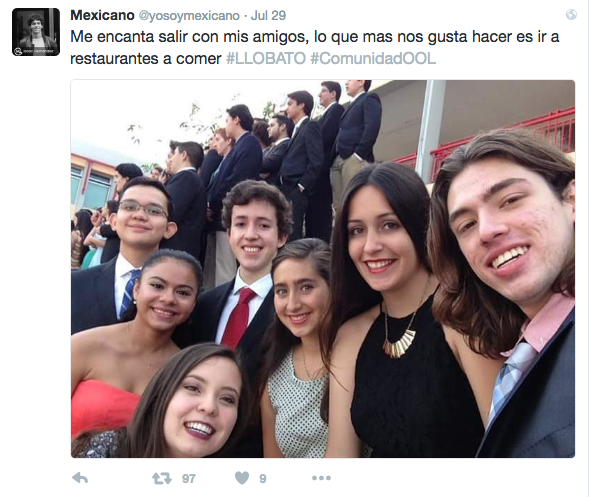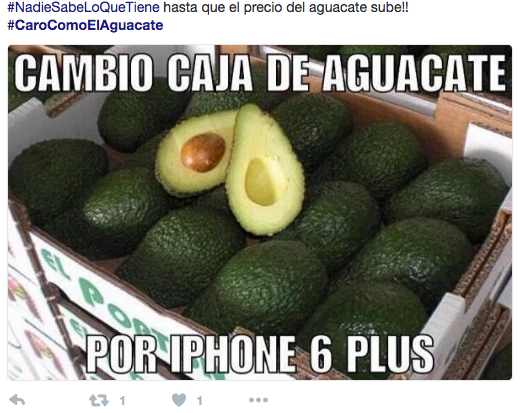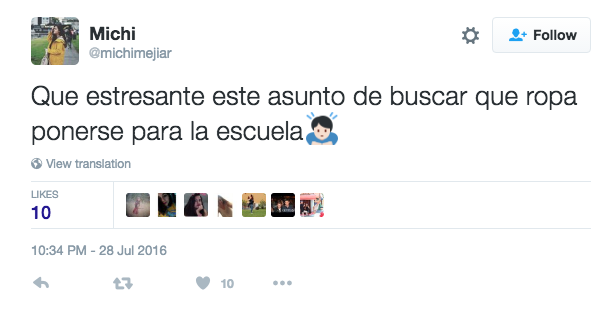For those of you who are still avoiding Twitter to streamline your social media life or for whatever reason (I know you’re out there!) I have good news – you don’t have to join Twitter to leverage it as a resource for your teaching, and WOW what a resource it is. Twitter is tailor-made for comprehensible authentic language perhaps without equal in the digital world (maybe infographics are equal) because people are limited to 140 characters. Let me quickly point out the three best ways I’ve found to put Twitter to use in the classroom.
Individual accounts
 Individual accounts are best used for students to explore something that interests them or that fits within a unit theme, but you can also use them to find your own content to incorporate. One of the recent gems I stumbled upon is the account of Pictoline. It’s like someone made a Twitter news account for 21st-century Spanish language learners. Think of it as a cross between an infographic, a news article, and a YouTube video: every day they tweet the “Daily Gif,” a short video slideshow of pictures and text relating the most relevant news of the day.
Individual accounts are best used for students to explore something that interests them or that fits within a unit theme, but you can also use them to find your own content to incorporate. One of the recent gems I stumbled upon is the account of Pictoline. It’s like someone made a Twitter news account for 21st-century Spanish language learners. Think of it as a cross between an infographic, a news article, and a YouTube video: every day they tweet the “Daily Gif,” a short video slideshow of pictures and text relating the most relevant news of the day.
What to do with it: I’ll be adding this to my homework choice options, for students to check the daily gif every day for a week and report to me two or three news items they found interesting.
 Of course, it doesn’t have to be news. Kids can check out the Twitter accounts of everyone from the president of Mexico to Sie7e to El Prado to Univisión to TeamMessi (bilingual) to Plaza Sésamo to LaVozKids. And here’s another one of my new favorites: YoSoyMexicano. Every week they feature tweets profiling a particular Mexican; it seems they’re usually a talented youth. You get to know the person, who they are, what they like, favorites and dislikes – sound anything like your first units in level 1?! You can’t buy this in a textbook, my friends!
Of course, it doesn’t have to be news. Kids can check out the Twitter accounts of everyone from the president of Mexico to Sie7e to El Prado to Univisión to TeamMessi (bilingual) to Plaza Sésamo to LaVozKids. And here’s another one of my new favorites: YoSoyMexicano. Every week they feature tweets profiling a particular Mexican; it seems they’re usually a talented youth. You get to know the person, who they are, what they like, favorites and dislikes – sound anything like your first units in level 1?! You can’t buy this in a textbook, my friends!
What to do with it: I’ll also be adding @YoSoyMexicano to my homework choices (outline a profile of one of the featured Mexicans), as well as using it to start this year with a review of last year’s focus on talking about ourselves. It will make a great bridge to talking about someone else.
Trending topics (hashtags)
To know what a trending topic is, first you have to know what a hashtag is. Simply put, a hashtag is a word or series of words with the # symbol in front of them. It makes it easy to search for that particular string of words/characters so you can see what people are saying about something. When a hashtag gets very popular, within the top ten used in a specific area or worldwide, it is said to be trending. Twitter keeps track of these trending topics. On the left side of your Twitter page, you’ll see the trending topics for the U.S. or your area. You can easily change that geographical area to another country or to an area within another country by clicking Change.
How to use them: A caveat: You have to be careful about trending topics. People know that these hashtags are getting a lot of views and will use them to disseminate any number of unsavory pictures, videos, and tweets. You don’t want to set your students off to explore a trending topic. A general hashtag such as #Venezuela is usually much more safe, but not the trending topics. Instead, check them out yourself. Many of them are fantastic for prompting thematic vocabulary and/or specific linguistic features. A few years ago the hashtag #quierounnovioque (I want a boyfriend that…) was trending, and you can imagine some of the garbage that came up from that, but you can also imagine how almost every tweet involved the use of subjunctive by reason of indefinite antecedent (which we didn’t call it, of course). I took several good ones and turned them into writing prompts for my intermediate students; check that out here and see how you might do something similar with a more recent trending topic.
Look at some recent trending topics in the Spanish-speaking world: #FelizMartes, #PorUnTransmiMejor (about the Colombian mass transit system El Transmilenio, #YaEsAgostoY. How to use them? How about finding a great one like this:
@carolamurillac: #YaEsAgostoY ahora sí que hago ejercicio… ok después de septiembre…
and using it to start a Tweetfest?

One of my favorite recent trends was #CaroComoElAguacate (expensive like the avocado) tracking the global challenge of the price of Mexican avocados in a very, very funny way. I just learned that 80% of the avocados exported in the world are grown in Michoacán, Mexico, so you can see how a drastic price increase would have far-reaching effects. The Twitter memes, though, were hysterical. My favorite involves someone being asked if he’d like regular or premium gas and his response, as he counts/throws cash, is “Premium, with all the additives, check all the levels, and toss in some avocado too!” (#carocomoelaguacate).
Specific themes

Like I said, there’s almost nothing like Twitter for accessible authentic language, which makes it a great place to exploit for anything related to your unit. Type in the theme / vocabulary in the target language (concert, school, restaurant, park, fun, etc.) and use it for a downtime Tweetfest or create an activity to go with it like I did with asking students to identify dates, times, places, and any other details for events across the Spanish-speaking world. Sometimes creating such an activity can be very time-consuming (and it was a station on a sub day so I didn’t even get to watch them do it!) but then I can share it with you and feel better about all the time I spent if you’re using it too. Oh, and when you create that activity, don’t forget to share it on the spreadsheet so we can all try it too.
Oh, and don’t forget the resource from Zachary Jones called Twiccionario.
Happy #AuthResAugust! Check out the AMAZING list of Spanish resources from Maris Hawkins and great stuff in French from Wendy Farabaugh and more great stuff in French from Megan Sulewski and keep the authentic resources coming! This stuff is hard work and we all make it easier by working together.
3 Comments
Comments are closed.



And there is the possibility of a Twitter chat which is a great interpersonal activity. Once a month Rebecca Huls hosts a Spanish student Twitter chat once a month during the school year. Search spanstuchat with a hashtag and you will see her website.
Great addition – can’t believe I forgot to add it! It’s already on my list of HW choice options for my older students! I also recommended it in the Twitter portion of my Brave Little Tailor workshop.
[…] you aren’t following along, here are some #AuthResAugust posts! Don’t forget to share […]